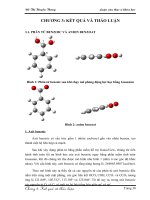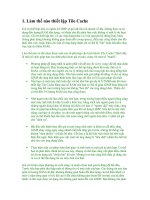The rock cycle (1)
Bạn đang xem bản rút gọn của tài liệu. Xem và tải ngay bản đầy đủ của tài liệu tại đây (722.27 KB, 33 trang )
The Rock Cycle
By:
Sarah Dowling
Rupa Kamboj
Joy Kim
Tony Tavlian
Jean Young
Basics
The Rock Cycle is a group
of changes in which:
Igneous rock can
change into
sedimentary rock or into
metamorphic rock
Sedimentary rock can
change into
metamorphic rock or
into igneous rock.
Metamorphic rock can
change into igneous or
sedimentary rock.
Igneous Rock
Igneous rock is formed when magma cools and makes
crystals.
Magma is a hot liquid made of melted minerals. The
minerals can form crystals when they cool.
Igneous rock can form underground, where the magma
cools slowly or igneous rock can form above ground,
where the magma cools quickly.
Sedimentary Rock
Sedimentary rocks form at or near the
earth's surface at relatively low
temperatures and pressures primarily by:
deposition by water, wind or ice
precipitation from solution (may be
biologically mediated)
growth in position by organic processes
(e.g., carbonate reefs )
Metamorphic Rock
Metamorphic Rock is formed when rocky material
experiences intense heat and pressure in the crust of the
earth.
Through the metamorphic process, both igneous rocks and
sedimentary rocks can change into metamorphic rocks, and
a metamorphic rock can change into another type of
metamorphic rock.
Heat and pressure do not change the chemical makeup of
the parent rocks but they do change the mineral structure
and physical properties of those rocks.
Pause Here
Sediment
Sediment can either be:
Material, originally suspended in a liquid, that settles at the
bottom of the liquid when it is left standing for a long time
Material eroded from preexisting rocks that is transported
by water, wind, or ice and deposited elsewhere
Plutonic and Volcanic Rock
Volcanic rocks, a.k.a extrusive rocks or lava
rocks, crystallize when the magma reaches the
earth’s surface cooling quickly.
Plutonic or intrusive rocks crystallize within the
crust of the earth, and as a result plutonic rocks
cool at a much slower pace then volcanic rocks
Melting
Melting is the result of continued heating
Leads to production of magma and new igneous rocks which
are formed when the the magma cools.
This process depends on the size of the reservoir that it drains
and the relative intensity or activity of plate tectonics.
Heat and Pressure
Metamorphic rocks trapped underground are still subject to
enormous heat from rising magma, or heated water, and
pressure. Sometimes the heat can get so intense the rocks
actually melt.
Pressure comes from the incredible weight of material
surrounding the rock on all sides.
The pressure pushes new minerals into the rock and drives
other minerals out; the result, of course, is that the rock is
chemically changed.
Weathering
The process in which rocks are broken down by chemical
and/or physical mechanisms into smaller particles.
There are three types of weathering
Physical weathering: physical action which breaks up
rocks. An example of this is freethaw weathering
Chemical Weathering: when the rock is attacked by
chemicals. An example of this is how acid rain breaks
down limestone.
Biological weathering: occurs when rocks are
weakened and broken down by animals and plants. A
tree root system that is slowly splitting rocks is an
example of this type of weathering..
Erosion
Erosion is the wearing away of exposed surfaces by agents
such as wind, moving water and ice. These agents usually
contain weathered rock debris. Rock fall under gravity is
also erosion.
Erosion influences orogenesis by changing the topography
and hence the thickness of the deforming orogen, which, in
turn results in modification of the gravitational force
relative to the tectonic driving force. Whereas efficient
erosion tends to localize deformation within a relatively
narrow belt, decrease in erosional efficiency causes
deformation to propagate toward more distal sites.
Subduction
A rock that gets caught up in the subduction zone may get
dragged down with the oceanic plate.
As the rock gets dragged down, they undergo metamorphism.
Some parts of the rocks get taken all the way down to the
mantle where they slowly mix with the rest of the mantle. – this
is the only way that rocks formed on the continent get recycled
with the mantle.
Compaction
The result of this pressure
is a compaction of the
sediment
it is squeezed together
causing a reduction in
pore space and a sticking
together of the grains.
Under pressure, some
chemical sediments, like
halite, may recrystallize
into a solid state.
Cementation
Most sediments are
deposited in water
containing dissolved
minerals.
The water flows through
the sediment and some of
these minerals precipitate
on the grain surfaces.
With time, this
intergranular material
effectively glues the
sediment together into a
cohesive solid- a
sedimentary rock.
Uplifting
Because certain rocks are created under the
Earth’s surface A process called uplifting
occurs through orogeny and volcanic
process, which then bring rocks to the
surface. The rock is eventually becomes
recycled again.
Transportation
This process occurs when the particles
created by weathering are carried by ice,
air, or water to a region of lower energy
known as a sedimentary basin.
Decomposition
Decomposition takes place when a lowering
of hydraulic energy, organic biochemical
activity, or chemical changes occur.
Crystallization
When hot conditions that caused magma to melt will cool, either
because the source of heat subsides or the magma moves into cooler
regions of the Earth.
When it gets cool enough the minerals that will make up the rock
begin to crystallize and form an intergrown mass of crystals.
If the crystals begin to form deep in the Earth where it is relatively
warm the magma cools slowly allowing the crystals to grow relatively
large.
If the magma reaches the surface, the lava cools quickly and the
crystals do not have time to grow very large.
If the crystals cannot grow at all and volcanic glass is formed.









